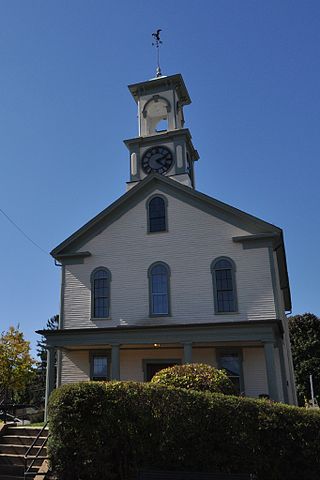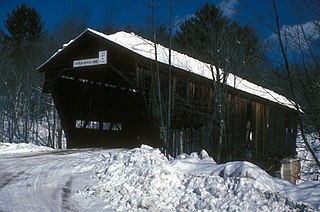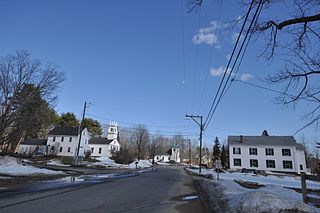
The Amesbury Friends Meetinghouse is a Friends Meeting House at 120 Friend Street in Amesbury, Massachusetts. Built in 1850 under the guidance of John Greenleaf Whittier, it is home to one of the leading Quaker congregations of the region, and historically hosted quarterly meetings for Quakers from across eastern Massachusetts and southeastern New Hampshire. The meetinghouse was listed on the National Register of Historic Places in 2002.

The Benjaminville Friends Meeting House and Burial Ground is a Friends Meeting House of the Religious Society of Friends (Quakers), located north of the rural village of Holder in McLean County, Illinois. It was once the site of a now-defunct village called Benjaminville, founded in 1856 after Quakers settled the area. More Quakers followed, and the burial ground, then the current meeting house in 1874, were constructed. This site, listed on the U.S. National Register of Historic Places since 1983, is all that remains of that village.

The Oblong Friends Meeting House is a mid-18th century Friends Meeting House of the Religious Society of Friends in the hamlet of Quaker Hill, in the town of Pawling, Dutchess County, New York, United States listed in the National Register of Historic Places since 1973.

The Arch Street Meeting House, at 320 Arch Street at the corner of 4th Street in the Old City neighborhood of Philadelphia, Pennsylvania, is a Meeting House of the Religious Society of Friends (Quakers). Built to reflect Friends' testimonies of simplicity and equality, this building is little changed after more than two centuries of continuous use.

The Greenfield Meeting House is a historic meeting house on Forest Road in the center of Greenfield, New Hampshire. The two-story wood-frame building was built in 1795; it is one of a small number of 18th century meeting houses in New Hampshire, and is believed to be the oldest still used for both religious and secular purposes, hosting both church services and town functions. The building was listed on the National Register of Historic Places in 1983.

The Early Settlers Meeting House is a historic church building at the junction of Granite and Foggs Ridge roads at Leighton Corners in the town of Ossipee, New Hampshire, United States. Built in the 1810s for a Free Will Baptist congregation and remodeled in 1856, it is a well-preserved example of a vernacular mid-19th century church. Now owned by the Ossipee Historical Society, the building was listed on the National Register of Historic Places in 1995.

The South Sutton Meeting House is a historic meeting house at 17 Meeting House Hill Road in South Sutton, New Hampshire. The wood-frame building was constructed in 1839, and is a well-preserved example of rural vernacular Greek Revival architecture. It was listed on the National Register of Historic Places in 1993.

The South Meetinghouse is a historic ward hall at 260 Marcy Street in Portsmouth, New Hampshire. Completed in 1866, it is one of the city's finest examples of Italianate architecture, and a rare surviving example of a 19th-century ward hall. The building was listed on the National Register of Historic Places in 1982. It continues to be used as a community resource.

The Dover Religious Society of Friends Meetinghouse is a historic Quaker meeting house at 141 Central Avenue in Dover, Strafford County, New Hampshire. Built in 1768 for a congregation established in the 17th century, it is the only surviving 18th-century Quaker meetinghouse in the state. The building was listed on the National Register of Historic Places in 1980.

The South Starksboro Friends Meeting House and Cemetery is a historic Quaker meeting house and cemetery on Dan Sargent Road in Starksboro, Vermont. Built in 1828 and last significantly updated in the 1870s, it is the oldest Quaker meeting house in Vermont, and continues to see regular use. It was listed on the National Register of Historic Places in 1985.

Beekman Meeting House and Friends' Cemetery is located on Emans Road in LaGrangeville, New York, United States. The meeting house is a wooden building from the early 19th century that has been unused and vacant for decades. As a result, it is in an advanced state of decay, and mostly collapsed. The cemetery, better preserved, is located a short distance away.

Chichester Friends Meetinghouse is a historic Quaker meeting house at 611 Meetinghouse Road near Boothwyn, in Upper Chichester Township, Delaware County, Pennsylvania. This area, near Chester, was one of the earliest areas settled by Quakers in Pennsylvania. The meetinghouse, first built in 1688, then rebuilt after a fire in 1769, reflects this early Quaker heritage. The building was added to the National Register of Historic Places in 1973.

The Old Chappaqua Historic District is located along Quaker Road in the town of New Castle, New York, United States, between the hamlets of Chappaqua and Millwood. It was the original center of Chappaqua, prior to the construction of the New York and Harlem Railroad and the erection of its station to the south in the mid-19th century. In 1974 it was recognized as a historic district and listed on the National Register of Historic Places.

The High Tops School, also known as Schoolhouse No. 9, is a historic school building at the corner of Reynolds and River roads in Westmoreland, New Hampshire. Built in 1789 and remodeled in 1846, it is one of a small number of district schoolhouses in the region to survive demolition or adaptation to residential use. The building was listed on the National Register of Historic Places in 1984, and the New Hampshire State Register of Historic Places in 2007. It is now owned by the Westmoreland Park Hill Meeting House and Historical Society.

The Durgin Bridge is a covered bridge carrying Durgin Bridge Road over the Cold River in eastern Sandwich, New Hampshire. Built in 1869, it is a rare surviving example of a Paddleford truss bridge, and one of the few surviving 19th-century covered bridges in New Hampshire. It was listed on the National Register of Historic Places in 1983.

Hansen's Annex is a historic house on Main Street in Center Sandwich, New Hampshire, United States. Built about 1839, it is one of a small number of Greek Revival buildings to survive, out of many that once graced the town. It has seen use as a single-family residence, tavern, and boarding house. It was listed on the National Register of Historic Places, and included in the Center Sandwich Historic District, in 1983.

The Bradbury Jewell House is a historic house at 154 Ferncroft Road in Sandwich, New Hampshire. Built about 1802 by an early surveyor of the region, it is a well-preserved example of high-quality second-generation frontier architecture. It was listed on the National Register of Historic Places in 1986.

The Lord's Hill Historic District encompasses a historic village center in Effingham, New Hampshire. Located along New Hampshire Route 153 on a hill in northern Effingham, it is a well-preserved late 18th and early 19th-century rural village. It is named for Isaac Lord, a leading figure in its development in the early 19th century. The district was listed on the National Register of Historic Places in 1985.

The Lower Corner Historic District encompasses a small village center in the town of Sandwich, New Hampshire. Lower Corner is a rural village that is strung along New Hampshire Route 109 on either side of its junction with School House Road, about one mile from the main village of Center Sandwich. The village was developed relatively early in Sandwich's history, although its oldest buildings now date to the early 19th century. There are 25 contributing structures, mostly residences. There are two buildings built as stores, including one of brick; all the other buildings are wood frame. The district was listed on the National Register of Historic Places in 1986.

The Deerfield Center Historic District encompasses the heart of the rural New Hampshire town of Deerfield. It extends northwest along Church Street from its junction with North Road, Candia Road, and Raymond Road. It includes many of the town's municipal buildings, as well as a church and private residences, most of which were built before about 1920. The district was listed on the National Register of Historic Places in 2002.























